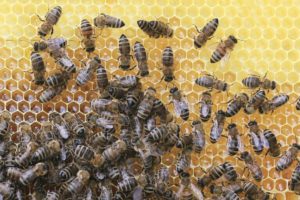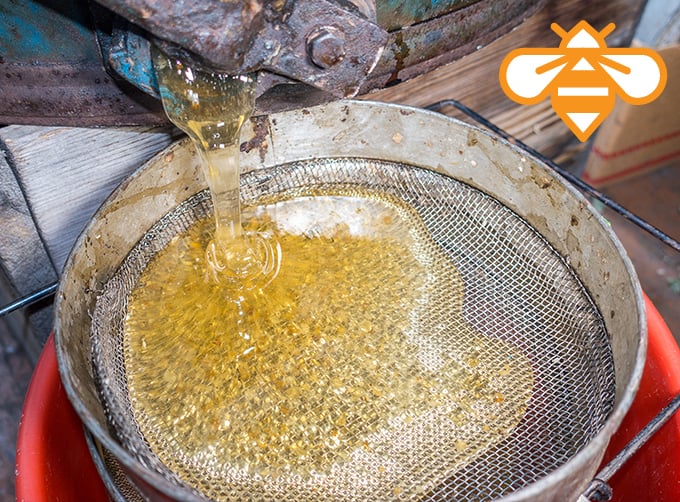Early History of Beekeeping
The first evidence of honey collection comes from Spain, at least 15,000 years ago. These honey collectors were not beekeepers, but would collect honey from wild hives. It wasn’t until 10,000 years later, in ancient Egypt, that organized beekeeping was first recorded. It is speculated that beekeepers transported their hives up and down the Nile to follow warm weather and blooming flowers. In ancient Egypt, honey was a luxury that was often included with treasures at burial sites. Unearthed graves have revealed this ancient honey, perfectly preserved.
Although it’s impossible to know for sure when and how beekeeping began, the people of early civilizations learned quickly to knock down the hives and “make a beeline” out of the area, then return when the bees had dispelled a bit. Those early honey harvesters also discovered how smoke repels bees, so they probably carried a lighted torch to defend themselves. While the joys of honey were widely enjoyed by humans, ancient beekeeping was deadly to bees involved. Before honey could be harvested, entire colonies were killed. This was because the only way to access the golden nectar was to break the hive open; rather than face a swarm of angry bees, beekeepers would suffocate colonies by holding a piece of burning sulfur to the small opening to the hive.
Honey is mentioned in the earliest written histories (about 2100 B.C.), but its actual use extends back many years. Consuming honey must have given humans an appreciation for the creatures that produced it, as well as the risks taken by people to harvest it. Likely, honey was a welcome addition to the diets of primitive communities that dined on simple foods. To find a wild hive was a treasure indeed, and its location would have been a carefully guarded secret. Not only the taste of honey but also its healthful properties made it a desirable and valuable commodity.
Our Bee Blankets will maintain a consistent temperature, ensuring your honey is always at the perfect temperature. For a 5-gallon bucket or a 55-gallon drum, the Bee Blanket keeps honey at the proper viscosity without creating crystallization due to overheating.
Finding the Sweet Spot
The Egyptians are credited with the first attempts to domesticate bees and beehives, making “natural” hives from hollow trees and logs to imitate the bees’ nature of hive building. They learned beekeeping techniques and moved their hives to follow the warm weather and blossoming buds. Honey was a luxury reserved for the upper class. And using it in this life was not enough; the Egyptians included jars of honey, found intact and well preserved in modern times, with the buried treasures of royalty.
The popularity of beekeeping spread from Egypt to Greece and Rome. The Roman poet Virgil even wrote guides to beekeeping. Beekeeping was practiced in Europe, and Spanish conquerors took beehives with them to South America. In the 17th Century, George Wheler, an English clergyman and travel writer, described in his adventures the beehives kept by the Grecians; these hives had removable frames for ease in drawing out the honey.
Hive Developments
While some beehives were constructed in trees, many wild hives are found clinging to the niches of steep cliffs (a better strategy on the bees’ part), thereby deterring—or at least discouraging—the honey hunters from disturbing the hives. Yet undaunted, determined seekers of honey learned to work as a team and obtain ropes to make their descent down dangerous canyons in order to seize the hives and get the precious contents.
In 1770, the book “A Treatise on the Management of Bees”, was written by Englishman Thomas Wildman. In his book, Wildman provided plans for a beehive that prevented the killing of bees. This hive style is fairly similar to what is popular today. It included a skep with an open top and a woven, removable lid. Wildman also developed hanging frames that provided structure for the bees to deposit honey rather than building a freeform structure. The design further prevented harm to bees by incorporating stacked skeps. This development provided a new space for bees to migrate to after filling one skep. This allowed beekeepers to harvest honey from a filled skep without overly disturbing bees.
In 1851, Lorenzo Lorraine Langstroth, “the Father of American Beekeeping”, improved upon Thomas Wildman’s design. Langstroth made the crucially innovative discovery that providing only one centimeter of “bee space” between the hanging frames would prevent bees from building small bridges of comb and propolis between the structures. This adjustment in space allowed beekeepers to remove frames without ripping any bee-made forms, which kept bees happier and helped beekeepers better monitor their hives for progress and disease. Additional adjustments Langstroth made to hives included replacing woven skeps with wooden boxes.
In 1863, the Frenchman Charles Dadant discovered that using larger boxes could significantly increase honey production. He noticed that after mating, queen bees were reluctant to move up stacked skeps to lay eggs; they preferred to lay eggs in a single box. By providing a larger box, queen bees would lay more eggs, which meant more workers bees. Dadant’s hive design featured a deeper box that gave the queen plenty of room to lay maximum eggs.
Using Bees for Pollination
In the mid-1700s, it was observed that bees were good pollinators. It wasn’t until 1750 that the role of bees as pollinators was first recorded. At the turn of the 20th century, American beekeepers began using hives as pollinators rather than solely as honey producers. In 1930s Denmark, the practice of renting out hives to farmers for aid in pollination began. This practice is widely used today, most notably in California, where 50% of US bees are transported each year to ensure almond trees are adequately pollinated. In this writer’s own neighborhood, one man noticed the abundance of bees one spring and attributed his hearty home garden harvest to a new neighbor’s keeping of bees.
Beeswax
Honey was just one treasure of a beehive. Perhaps the early honey harvesters realized that their hot torches used to subdue the bees could melt the beeswax, and when the wax was isolated from the honey, it was recognized as a very useful substance.
Over ten thousand years ago, the Egyptians kept bees. They learned to use beeswax in embalming their dead; the wax also proved practical in sealing coffins. Known for their early writing skills, the Egyptians employed beeswax in their writing instruments both on papyrus and on stone. Perhaps they first learned the healthful properties of beeswax in the formulation of skin creams and healing ointments.
The Chinese also recognized the worth of beeswax for medicinal purposes as a salve for wounds and even a food supplement. They valued beeswax for beauty purposes and anti-aging appearance.
The Chinese, the Egyptians, ancient Greeks and other civilizations made beeswax candles; such candles were exclusively preferred in churches. One can only imagine the vast amounts of candles consumed in religious rites. The pure wax, untainted with other elements such as tallow or resins, was highly sought; thus apiariums, or beehive collections, were found in many monasteries and abbeys.
Beeswax became a valuable trade commodity among nations; it was used as currency in Europe in the 13th and 14th centuries. Chinese royalty used only beeswax candles, whereas the poor had just the tallow variety.
Nowadays, the beeswax industry is a lucrative one as it has become an important element in soap, creams, and health products. Countless recipes implementing beeswax for homemade health and beauty products, food supplements and even candles are available to the Internet-browsing public.
Beekeeping Today
Modern technology is all abuzz with better ways to make life easier for beekeepers. After years of being stung during the honey harvest—and regrets about losing so many bees during the process—beekeepers Stu and Cedar Anderson of Australia had the idea of splitting the hexagonal cells, which allows the honey to be extracted more efficiently. In fact, the honey will drain down and can be drawn out of the hive with a simple faucet. The inventor calls the system Flow Hive and has sold thousands of such hives around the world. These hives are bee-friendly and beekeeper-friendly, and they have streamlined the honey industry.
Beekeeping today most popularly involves Dadant-style hives. However, developments and innovations are providing exciting new options. For example, after years of being stung during the honey harvest—and regrets about losing so many bees during the process—beekeepers Stu and Cedar Anderson of Australia had the idea of splitting the hexagonal cells, which allows the honey to be extracted more efficiently. The Flow Hive, allows beekeepers to quickly and efficiently harvest honey from a tap attached to the hive without disturbing bees and without the risk of getting stung.
Another example of new technology that simplifies beekeeping is the Powerblanket Bee Blanket. After it has been harvested, the Bee Blanket keeps honey at hive temperatures so that it won’t lose nutrients or burn. The Bee Blanket works on both poly and steel buckets/pails and keeps honey at the proper viscosity without creating crystallization due to overheating. If you are looking for options to simplify or innovate your beekeeping, consider adding these products to beekeeping routine.
Way to Bee
One cannot learn about honey and beeswax without gaining an appreciation of the bees themselves. By nature they are driven to pollinate, gather nectar, and condense the nectar into honey. It is estimated that an average hive of 20,000 to 60,000 bees must collectively travel the equivalent of twice around the world and visit millions of flowers in order to produce a pound of honey. One honeybee will contribute about a twelfth of a teaspoon of honey to a hive during the bee’s lifetime of four to 16 weeks.
Although an individual bee’s contribution of one-twelfth of a teaspoon of honey may seem insignificant, each bee is essential to the life and maintenance of the hive. Obviously the work of a hive cannot be accomplished by just a few bees. They work together for the prosperity of the hive. The honeybee and the beehive stand as symbols of cooperation, hard work and industry; hence our expression “busy as a bee.”
The Powerblanket Bee Blanket will maintain the same temperature as a hive, ensuring your honey is always at the perfect temperature.








